Learn the requirements for AED signs, exit signs, and fire extinguisher signs
No one expects an emergency to happen. But when they do occur, life and fire safety signs that illuminate the path to safety or the location of critical life safety equipment can save lives. In this blog, we examine model code requirements for some of the most important life and fire safety signage in a building, including:
To learn about the extensive signage requirements for fire sprinkler systems, read our previous blog: “Complete Guide to Fire Sprinkler Signs and System Marking.”
Keep in mind that while most jurisdictions use International Fire Code (IFC), International Building Code (IBC), and National Fire Protection Association (NFPA) codes as the model for local laws, many also add amendments that are specific to their areas. For this reason, it’s always important to check local fire and building ordinances for the most accurate signage requirements.
Need life and fire safety signs for your building? Browse our selection of fire sprinkler signs, exit signs, photoluminescent exit and emergency equipment (such as AED) signs, fire extinguisher decals, and more.
When every second counts, AED signs make it easy to locate lifesaving equipment
Every year, sudden cardiac arrest claims the lives of more than 475,000 Americans, according to the American Heart Association (AHA). A timely response is key to survival—but less than half of cardiac arrest victims receive immediate help, as emergency medical services take an average of four to 10 minutes to arrive. For every minute that passes without CPR and defibrillation, a victim’s chances of survival decrease by 7 to 10%.
A publicly available automated external defibrillator (AED) used by a bystander can more than double the chances of survival, AHA reports. For this reason, all 50 states have enacted laws requiring AEDs in varying public gathering places, from gyms to government buildings to school athletic settings.
But too many AEDs are tucked away in cluttered, forgotten corners—making them difficult to find. While it may be tempting to keep expensive equipment out of harm’s way, making AEDs easy to locate quickly is critical to saving lives.

Most AED manufacturers recommend that facilities have at least one AED on every floor of a building. And when someone shouts, “Where’s the AED?!,” clear signage should mark AED locations and direct users to the device. Directional signs should be placed in high-traffic areas like elevators, stairways, and lobbies. Glow-in-the-dark signs that protrude from the wall like the Everlux Glow-in-the-Dark AED Sign help stop AEDs from blending into their surroundings.
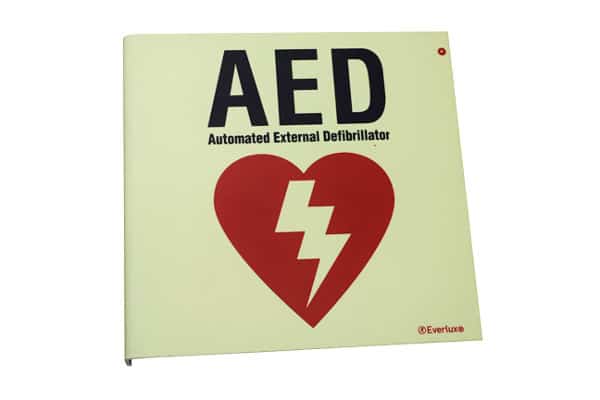
AEDs should be readily accessible to all employees and the public and within reach of individuals who use wheelchairs. Guidelines from the American Disabilities Act (ADA) recommend mounting AED cabinets in unobstructed areas no more than 48 inches above the floor so anyone can access them in the event of an emergency.
Exit signs help people safely evacuate even the most maze-like structures
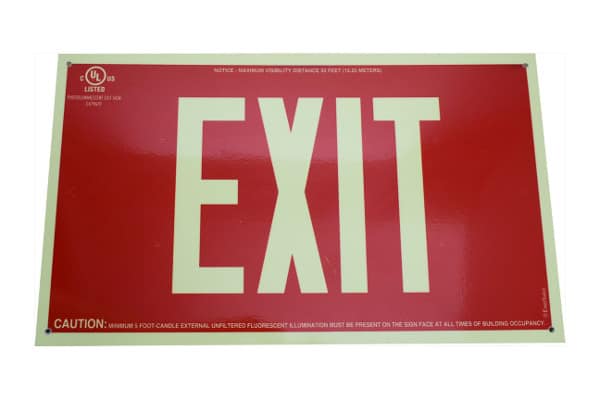
Exit signs help people quickly evacuate from buildings—especially complicated structures—during an emergency. And when a fire or natural disaster plunges a building into darkness, these signs must remain illuminated, guiding people to safety.
Not surprisingly, model codes devote a lot of attention to regulations governing exit signs. For a deep dive into what life safety code and federal law expect from exit signs, check out our previous blog, “Emergency Exit Signs and Lights: Regulations and Types.” That blog also addresses common concerns that crop up when selecting exit lights and examines code-compliant products that meet safety needs in modern buildings.
But here are the essentials of what you need to know about exit signs in your building:
Where are exit signs required?
In the model codes, a means of egress includes:
- The route from any location in a building to an exit
- The exit itself
- The path from the exit to a public way such as a street or alley
To make this path easy to follow, approved exit signs are generally required to mark every exit and exit access door in a facility.
The signage must be visible from any direction that people may travel and clear of any decorations, furnishings, or equipment that could make it difficult to see. Remember this rule from NFPA 101 (7.10.1.5.2) as well: no point in an exit access corridor or exit passageway should be more than 100 feet from the nearest visible exit sign.
Highly visible directional signage must also be placed anywhere the path to the nearest exit is not immediately obvious, or as directed by the local fire marshal. If stairs or ramps continue for more than a half-story past the floor level that exits are on, NFPA 101 (7.7.3.3) requires signage that stops people from traveling too far during emergency evacuations.
A.7.10.1.2.2 explains that stairway marking signs must clearly indicate the vertical direction to the exit discharge, and exit signs should be installed above stairway doors on the floor level that contains the way out. Model codes also require separate signage on the interior of stairway enclosures that indicate the floor level.
To further help people avoid getting lost or trapped in dead-end spaces during evacuations, NFPA 101 (7.10.8.3) also mandates signage on doors, passages, or stairways that might be mistaken for ways out. These signs must clearly indicate “NO EXIT” and may also note the actual usage of the space, such as “Electrical Room” or “Linen Closet.” The IFC has similar requirements:
From the 2018 edition of IFC
1013.1 Where required. Exits and exit access doors shall be marked by an approved exit sign readily visible from any direction of egress travel. The path of egress travel to exits and within exits shall be marked by readily visible exit signs to clearly indicate the direction of egress travel in cases where the exit or the path of egress travel is not immediately visible to the occupants. Intervening means of egress doors within exits shall be marked by exit signs. Exit sign placement shall be such that no point in an exit access corridor or exit passageway is more than 100 feet (30 480 mm) or the listed viewing distance for the sign, whichever is less, from the nearest visible exit sign.
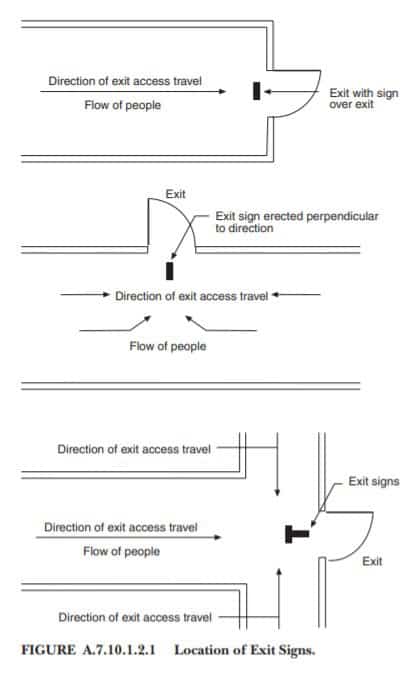
There are a few notable exceptions to model code requirements. When the main entrance also serves as an exit, its use is generally deemed obvious enough that no exit sign is required.
NFPA 101 (A.7.10.1.2.1) explains that the character of an occupancy has “a practical effect” on the need for signs. For instance, labeling exits is more important in buildings where different people continuously come and go like hotels than it is in places like apartment houses, where the same people use the exits regularly. But even in these permanent residence-type structures, NFPA notes that signs must readily identify exits that aren’t commonly used, like outside stairs.
IFC notes that exit signs are not required in:
- Rooms or areas that only require one exit or exit access.
- Main exterior exit doors or gates that are obviously and clearly identifiable as exits, if approved by fire code officials.
- Occupancies in Group U, comprised of utility buildings like barns and water towers.
- Individual sleeping units or dwelling units in Group R-1 (transient properties like hotels), R-2 (residences where occupants are primarily permanent like dormitories), or R-3 (permanent occupancies that have two or fewer units like small childcare facilities).
- Dayrooms, sleeping rooms, or dormitories in occupancies in Group I-3, which includes uses where people are kept under restraint like correctional facilities.
- Occupancies in Groups A-4 (indoor viewing of sporting events and activities) and A-5 (outdoor viewing) do not need exit signs on the seating side of “vomitories”—openings that permit large numbers of people to pass through—if signs provided in the concourse are easy to see. However, egress lighting must identify each vomitory or opening within the seating area during an emergency.
What should exit signs look like?
Highly visible exit signs are critical to helping people escape a dangerous situation. History is littered with tragedies like the Iroquois Theater Fire of 1903, where countless lives were lost because power outages made it impossible to find the path to safety.
Model codes mince no words in requiring property owners to install exit signs that are illuminated at all times—even if the power goes out. But read this carefully: continuous illumination does not imply that emergency lighting is always required to make signs visible in the dark.
The mandate for continuous illumination simply means that the sign must be visible and legible at a 100’ distance under any level of lighting in a room. In addition to electric exit signs, self-luminous and photoluminescent exit signs can fulfill this purpose when listed in accordance with UL 924: Standard for Emergency Lighting and Power Equipment.
From the 2018 edition of IFC
1013.3 Illumination. Exit signs shall be internally or externally illuminated. Exception: Tactile signs required by Section 1013.4 need not be provided with illumination.
1013.4 Raised character and braille exit signs. A sign stating EXIT in visual characters, raised characters and braille and complying with ICC A117.1 shall be provided adjacent to each door to an area of refuge, an exterior area for assisted rescue, an exit stairway or ramp, an exit passageway and the exit discharge.
1013.5 Internally illuminated exit signs. Electrically powered, self-luminous and photoluminescent exit signs shall be listed and labeled in accordance with UL 924 and shall be installed in accordance with the manufacturer’s instructions and Section 604. Exit signs shall be illuminated at all times.
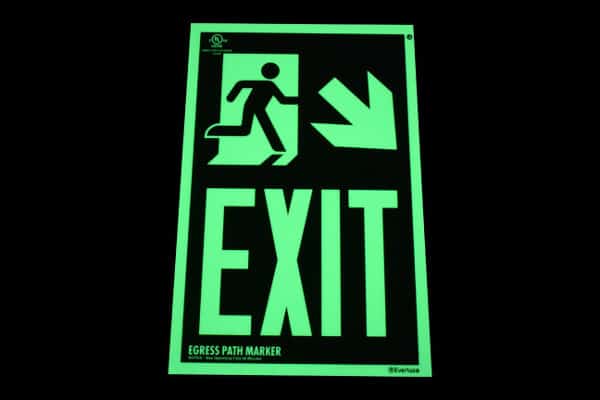
Exit signs must feature a size, distinctive color, and design that’s easy to see—contrasting with nearby decorations, the building’s interior finish, and other signs. NFPA 101 (7.10.1.8) emphasizes that no other brightly illuminated sign, display, or object may be placed within people’s line of vision that could detract their attention from the exit sign.
NFPA 101 (A.7.10.1.8) notes that red is the traditional color for exit signs and is even required by law in some jurisdictions. However, earlier editions of Life Safety Code instigated the use of green exit signs, noting that in traffic lights, “green” indicates safety, and “red” signals people to stop. The existing code avoids specific color requirements, assuming red or green will be used unless circumstances require another color to provide greater visibility.
Generally, model codes require signs to display the word “EXIT” prominently. However, NFPA 101 (7.10.3.2) allows pictograms in compliance with NFPA 170: Standard for Fire Safety and Emergency Symbols to be used with or instead of signs with text if approved by the local AHJ.
From the 2018 edition of IFC
1013.6 Externally illuminated exit signs. Externally illuminated exit signs shall comply with Sections 1013.6.1 through 1013.6.3.
1013.6.1 Graphics. Every exit sign and directional exit sign shall have plainly legible letters not less than 6 inches (152 mm) high with the principal strokes of the letters not less than 3/4 inch (19.1 mm) wide. The word “EXIT” shall have letters having a width not less than 2 inches (51 mm) wide, except the letter “I,” and the minimum spacing between letters shall be not less than 3/8 inch (9.5 mm). Signs larger than the minimum established in this section shall have letter widths, strokes and spacing in proportion to their height.
The word “EXIT” shall be in high contrast with the background and shall be clearly discernible when the means of exit sign illumination is or is not energized. If a chevron directional indicator is provided as part of the exit sign, the construction shall be such that the direction of the chevron directional indicator cannot be readily changed.
The 2018 edition of NFPA 101 (7.10.6.2.1) adds more specific requirements for directional indicators, stating that they should be:
- Located outside the “EXIT” legend, not less than 3∕8” (9.5 mm) from any letter
- Of a chevron type
- Identifiable as a directional indicator from a distance of 40’ (12 m)
- Located at the end of the sign for the direction indicated
IFC also addresses the brightness and power sources for externally illuminated exit signs:
1013.6.2 Exit sign illumination. The face of an exit sign illuminated from an external source shall have an intensity of not less than 5 foot-candles (54 lux).
In the lighting industry, footcandles are a standard unit of measurement used to determine how much light is optimal for workspaces, retail venues, buildings, or outdoor spaces. A footcandle represents the illuminance on a one-square-foot surface from a uniform source of light. The five footcandles suggested as the minimum for exit signs are similar to the minimum level of brightness maintained in a covered parking garage.
1013.6.3 Power source. Exit signs shall be illuminated at all times. To ensure continued illumination for a duration of not less than 90 minutes in case of primary power loss, the sign illumination means shall be connected to an emergency power system provided from storage batteries, unit equipment or an on-site generator. The installation of the emergency power system shall be in accordance with Section 604. Group I-2, Condition 2 exit sign illumination shall not be provided by unit equipment batteries only.
Exception: Approved exit sign illumination types that provide continuous illumination independent of external power sources for a duration of not less than 90 minutes, in case of primary power loss, are not required to be connected to an emergency electrical system.

Highly visible fire extinguisher signs help people locate extinguishers before it’s too late
Portable fire extinguishers represent a critical first line of defense in a building when fires break out, with the ability to put out small fires or effectively contain them until fire departments arrive. Data collected over 34 years by the National Association of Fire Equipment Distributors (NAFED) shows that in 13,221 fire incidents, fire extinguishers successfully extinguished flames 95% of the time.
NFPA 1: Fire Code mandates fire extinguishers in almost every type of building, except family homes, duplexes, and manufactured homes. But because fire extinguishers are only designed to control fires in the earliest stages—and because fire can spread alarmingly fast—their window of effectiveness will snap shut if they can’t be located quickly.
Highly visible signs that clearly mark the location of fire extinguishers are the best way to help people find them before flames rage out of control.
Some model codes stop short of mandating the specific use of signs. But the language in the 2018 edition of NFPA 10: Standard for Portable Fire Extinguishers implies that inspectors are likely to expect a noticeable fire extinguisher sign—particularly if the extinguisher is located inside a cabinet, in a large room, or in a place where the extinguisher is blocked from being easily seen.
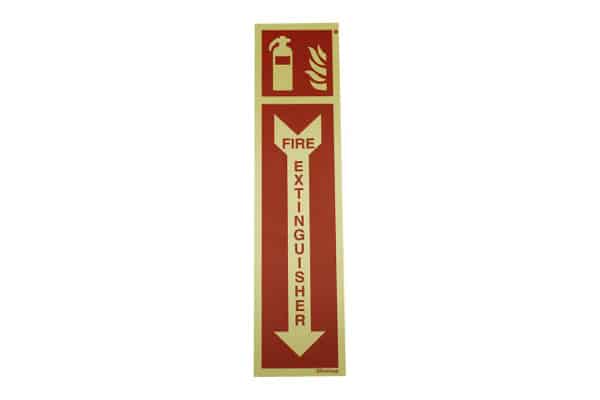
NFPA 10 (6.1.3.10.2) requires fire extinguishers housed within cabinets to be “marked conspicuously” when there is a possibility that obstructions within people’s line of sight could make them hard to spot. Section 6.1.3.3.2 goes a step further, specifying the use of “signs or other means” to indicate extinguisher location in places where visual obstructions like open doors or machinery can’t be avoided.
From the 2018 edition of NFPA 10
6.1.3.3.1 Fire extinguishers shall be installed in locations where they are visible except as permitted by 6.1.3.3.2.
6.1.3.3.2 In rooms and in locations where visual obstructions cannot be avoided, signs or other means shall be provided to indicate the extinguisher location.
6.1.3.10.2 The location of fire extinguishers as described in 6.1.3.3.2 shall be marked conspicuously.
However, regardless of requirements, NFPA 10’s Annex A makes it clear that code makers’ intent is for property owners to primarily rely on fire extinguisher signs to locate this critical fire safety equipment:
From the 2018 edition of NFPA 10
A.6.1.3.3.2 The primary means for identifying the locations of fire extinguishers should be by the installation of fire extinguisher signs that are specifically designed for that purpose. Examples of other means of identifying the fire extinguisher locations include arrows, lights, or coding of the wall or column.
NFPA offers few requirements for what fire extinguisher signs should look like, giving property owners some leeway in determining the best way to enhance visibility. OSHA (Occupational Safety and Health Administration) regulations (1910.157(c)(1)) are similarly vague, merely instructing employers to “mount, locate, and identify” fire extinguishers, so they are “readily accessible” to employees.
From the 2018 edition of NFPA 10
6.1.3.3.3 Signs or other means used to indicate fire extinguisher location shall be located in close proximity to the fire extinguisher.
6.1.3.3.4 Signs or other means used to indicate fire extinguisher location shall be visible from the normal path of travel.
Even so, best practices (and common sense) dictate that the best way to eliminate any possibility of confusion is choosing signs in bold colors with large letters proclaiming, “FIRE EXTINGUISHER.” They should be easily seen from up close, different angles, and at a distance.
Glow-in-the-dark fire extinguisher signs that feature text, a pictograph, and an arrow pointing to the extinguisher make firefighting equipment especially hard to miss—even in dark or low-light conditions. Signs should be carefully placed, so nothing obstructs a person’s view.

Strategically placed signs can also warn people of the substantial repercussions of fire extinguisher tampering. News stories and YouTube videos abound of pranksters using fire extinguishers to vandalize property. Just a few days ago, kids caused thousands of dollars in damage at an Oregon movie theater by stealing three fire extinguishers and unloading another one in two empty theaters.
Not only can fire extinguisher tampering lead to expensive clean-up, but it also leaves people and property unprotected from fire. Signage posted on fire extinguisher cabinets that spells out the penalty for this “harmless” prank could go a long way toward making potential vandals think twice.

Fire safety signs can keep emergencies from becoming tragedies
When there isn’t a moment to lose, highly visible life and fire safety signs can stop emergencies from spiraling out of control—helping people find what they need to alleviate or safely evacuate a dangerous situation. Understanding code requirements for these critical signs helps building owners keep people and property safe and avoid fines for non-compliance.
Note that many other signs may be required in your building, including “area of refuge” signs and signage for various life safety systems, like fire sprinklers. So, check with your local authority having jurisdiction (AHJ) to learn all of the requirements in your area.
Need life and fire safety signs for your building? Browse our selection of fire sprinkler signs, exit signs, photoluminescent exit and emergency equipment (such as AED) signs, fire extinguisher decals, and more.
This blog was originally posted at blog.qrfs.com. Check us out at Facebook.com/QuickResponseFireSupply or on Twitter @QuickResponseFS.


